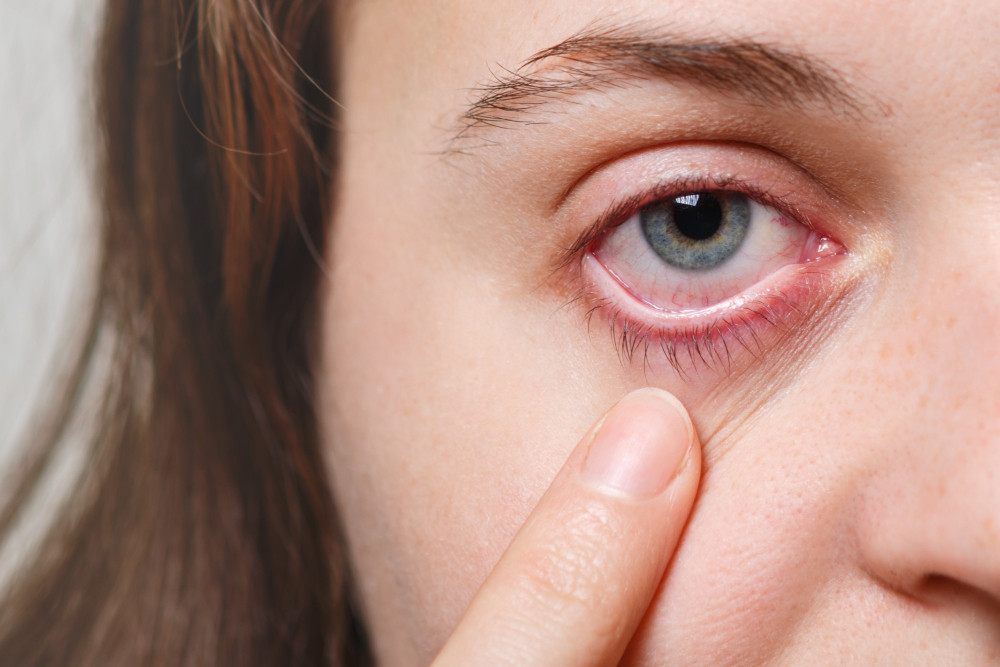Mata kering sering dialami ketika menggunakan lensa kontak dalam waktu yang lama atau terlalu lama memandang layar. Umumnya mata kering terjadi di kedua mata, namun kondisi ini juga bisa dialami pada satu mata saja. Apa penyebab mata kering sebelah? Simak ulasannya berikut ini.
Gejala Mata Kering Satu Sisi Mata
Meskipun jarang terjadi, namun Anda dapat mengalami mata kering hanya pada satu mata. Gejala dan penyebabnya mirip dengan kondisi mata kering pada kedua mata. Namun, gejala yang muncul dapat bervariasi tergantung pada penyebab yang mendasarinya.
Beberapa gejala yang dapat muncul antara lain:
- Gatal
- Mata terasa berpasir
- Nyeri, terbakar, atau kemerahan pada mata
- Penglihatan kabur
- Kesulitan memakai lensa kontak
- Kelelahan mata
- Rasa perih
Baca Juga: Memilih Lensa Kontak Jika Memiliki Mata Kering
Penyebab Mata Kering di Satu Sisi Mata
Secara umum terdapat dua jenis mata kering, yaitu:
Mata kering evaporatif (EDE)
Mata kering evaporatif atau evaporative dry eye (EDE) adalah kondisi mata kering yang paling sering terjadi. Mata kering akibat penguapan yang berlebihan ini terjadi ketika mata memproduksi air mata yang cukup namun terlalu cepat menguap sehingga mata terasa mudah kering.
Penyebab kondisi ini pada umumnya adalah adanya gangguan pada kelenjar meibom, yang merujuk pada penyumbatan kelenjar yang menghasilkan lapisan minyak pada lapisan air mata.
Gejala mata kering evaporatif antara lain:
- Mata kering atau gatal
- Mata merah
- Mata terbakar
- Mata lelah
- Mata bengkak
- Sensitivitas terhadap cahaya
- Mata berkerak
- Mata berair berlebihan
Penurunan produksi air mata
Mata kering juga bisa disebabkan oleh kondisi kekurangan produksi air mata atau aqueous deficient dry eye (ADDE). Kondisi ini terjadi ketika kelenjar lakrimal, yaitu kelenjar yang bertugas mengeluarkan air mata, tidak dapat menghasilkan cukup air mata untuk menjaga permukaan mata tetap sehat.
Penyebab kekurangan produksi air mata antara lain:
- Penyakit Sjögren, yaitu penyakit autoimun yang menyerang kelenjar penghasil air liur dan mata
- Peradangan atau disfungsi kelenjar lakrimal
- Penyumbatan pada kelenjar lakrimal
- Konsumsi obat-obatan sistemik seperti dekongestan dan antihistamin
Gejalanya meliputi:
- Mata kering terus-menerus
- Mata merah
- Mata iritasi atau berpasir
- Kelelahan mata
- Sensitivitas cahaya
- Mata berair
Selain penyebab di atas, banyak orang mengalami mata kering sebelah akibat adanya penyumbatan fisik pada kelenjar lakrimal yang bukan disebabkan oleh sindrom Sjögren.
Perlu juga diketahui bahwa terkadang gejala mata kering hanya muncul di salah satu sisi mata, meskipun kondisi ini sebenarnya mungkin terjadi di kedua mata. Faktor lain seperti pascaoperasi LASIK atau operasi katarak juga dapat menyebabkan mata kering.
Baca Juga: Cara Mengatasi Mata Kering Akibat Penggunaan Lensa Kontak
Penanganan Mata Kering
Penanganan mata kering perlu disesuaikan dengan penyebabnya. Jika mata kering disebabkan oleh gangguan pada kelenjar lakrimal, dokter dapat merekomendasikan pengobatan yang sesuai dengan kondisi mata.
Jika mata kering disebabkan oleh faktor lingkungan dan gaya hidup, penanganan bisa diberikan dengan perawatan rumahan yang disesuaikan dengan jenis dan tingkat keparahan kondisi penyakit. Beberapa cara penanganan mata kering antara lain:
- Menggunakan obat tetes mata
- Penekanan kelenjar meibom
- Kompres hangat dan pijat kelopak mata
- Hindari lingkungan yang kering atau berangin
- Gunakan pelembap udara untuk mencegah udara kering
- Menghindari penggunaan komputer atau screen time berlebihan
- Pembersihan kelopak mata secara teratur dengan sabun lembut atau produk pembersih kelopak mata
- Menggunakan lensa kontak khusus
- Tindakan penyinaran atau bedah sesuai anjuran dokter
Gangguan mata kering dapat terjadi pada satu atau kedua mata. Mata kering di satu mata merupakan kondisi yang jarang terjadi dan umumnya disebabkan oleh adanya gangguan pada kelenjar air mata.
Jika Anda mengalami mata kering yang tidak segera sembuh sebaiknya periksakan ke dokter. Anda juga bisa memanfaatkan fitur konsultasi pada aplikasi Ai Care yang bisa diunduh melalui App Store dan Play Store.
Mau tahu informasi seputar penyakit lainya? Cek di sini, yah!
- dr Nadia Opmalina
Smith-Garcia, D. (2023). Why Do I Have Dry Eye in Just One Eye?. Available from: https://www.healthline.com/health/why-do-i-have-dry-eye-in-one-eye#
Sissons, B. (2024). What causes dry eye symptoms in one eye?. Available from: https://www.medicalnewstoday.com/articles/dry-eye-in-one-eye
Mayo Clinic. Dry Eyes. Available from: https://www.mayoclinic.org/diseases-conditions/dry-eyes/symptoms-causes/syc-20371863
Cleveland Cliniic. Dry Eye. Available from: https://my.clevelandclinic.org/health/diseases/24479-dry-eye
NHS. Dry Eyes. Available from: https://www.nhs.uk/conditions/dry-eyes/
Ames, H. (2024). What are the different types of dry eyes?. Available from: https://www.medicalnewstoday.com/articles/types-of-dry-eye












